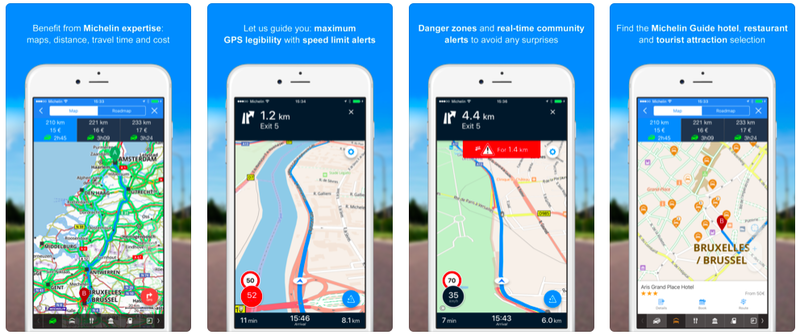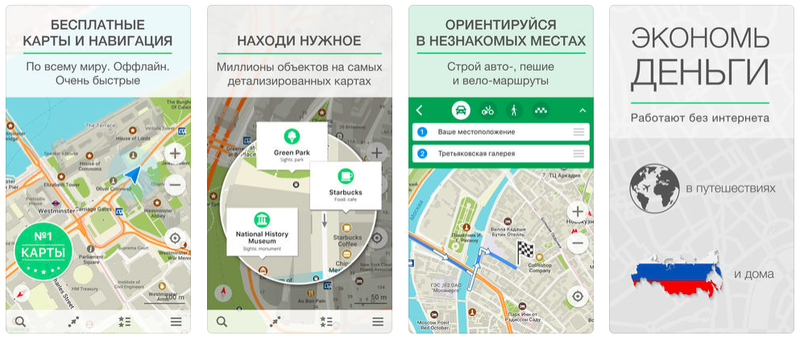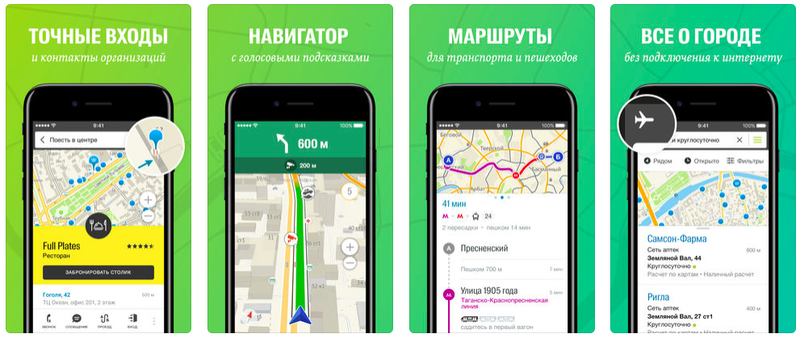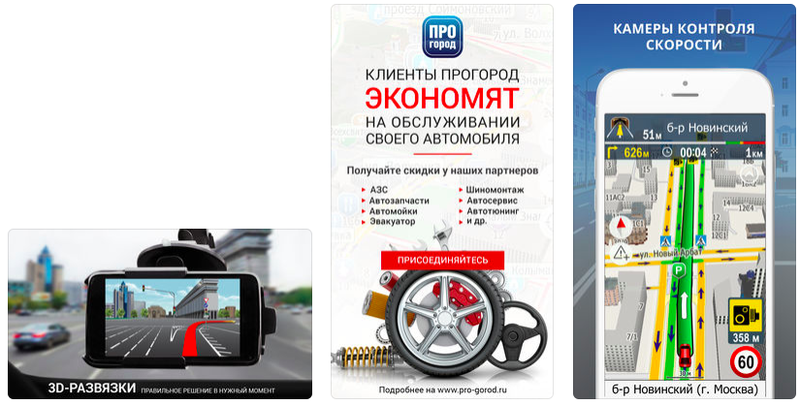Maps for iPhone: Yandex, Google, Maps.Me, 2GIS and others
The App Store navigation category contains a very wide range of applications. There are highly specialized auto trekkers and programs for sea trips, and even for pilots there are several applications. But there are common tasks that a large number of iPhone users face regularly. Let's try to collect the most relevant programs for such cases...
Simple maps for iPhone
So far, Apple's native Maps application does not work very well in our latitudes.
It is replaced by two popular programs:


Offline maps for iPhone
The above-mentioned Yandex Maps and Google Maps programs support the ability to create offline maps with the ability to use them without the Internet. This is described in detail at the end of the article. But it is not always possible to do this. So, Yandex has a very limited set of maps, and not everyone will mess with Google’s cache. Therefore, there are specialized applications that greatly facilitate this work.
There is also a service that is gaining popularity.


Car navigators for iPhone

Maps guides

You can make your guide this way.
If you have created your own tourist route, then you can transfer it to your smartphone like this.
Offline maps Yandex and Google
Yandex Maps program
In the latest versions of the program, it has become possible to save city maps in the phone’s memory, i.e. Now you can work with the map without connecting to a mobile network or the Internet. This significantly speeds up working with the application and will also save traffic for those who are not subscribers of Megafon, Beeline or Kyivstar.
Cities whose maps can be downloaded for offline viewing:
Angasrk, Artem, Barnaul, Belgorod, Berdyansk, Veliky Ustyug, Volzhsky, Vyazniki, Glazov, Dnepropetrovsk, Donetsk, Yekaterinburg, Zaporozhye, Yoshkar-Ola, Izhevsk, Ilyichevsk, Kazan, Kamyshin, Kemerovo, Kiev, Kramatorsk-Slavyansk, Krasnoarmeysk, Krasnoyarsk , Crimea, Kurgan, Leningrad region, Lvov, Magnitogorsk, Melitopol, Minsk, Moscow, Moscow region, Nezhin, Nizhnevartovsk, Nizhny Novgorod, Novokuznetsk, Novosibirsk, Odessa, Orenburg, Prokopyevsk, Rostov-on-Don, Samara, St. Petersburg, Sarapul, Saratov, Sumy, Surgut, Tambov, Tomsk, Uglich, Ulyanovsk, Usolye-Sibirskoye, Ussuriysk, Ufa, Kharkov, Cherepanovo, Chita.
There is also the opportunity to make maps of the desired area yourself.
Maps program Google map
Instructions on how to make google map work on iPhone without using the Internet.
Theory.
When you start the program, the necessary map fragments are loaded from the network themselves, using the wi-fi or gprs method available at that moment. The loaded areas of the map form a so-called cache, a temporary file. This cache is used for quickly redrawing the screen and in the event of a lack of connection with the server, i.e. for working offline.
This cache file is called MapTiles.sqlitedb and is a set of square tiles. Each level of detail has its own set. Fragments are not scaled. Likewise, satellite photography and a hybrid, each have their own independent set of fragments.
It would seem that if you look at the desired part of the map once, you can refer to it constantly. However, the program is designed in such a way that when the cache reaches a certain size, old areas of the map begin to be erased to free up space for new data, and it is not possible to assemble a full-fledged map in this way.
To get around this problem, you need to set a ban on overwriting the cached map by first loading the desired area of the terrain into your phone.
One more feature. With the change in firmware, the principle of card caching also changed. For iPad/iPhone4 fragments are used - 256x256 pixels, for iPhone 3GS/3G with firmware 2.2 - 128x128 pixels, for older firmware 64x64 pixels. In addition, the cache in different firmware versions is located in different places in the phone’s file system. Therefore, cards from old firmware do not fit the new ones; they need to be converted.
The map itself consists of 3 files:
- map in the form of fragments - MapTiles.sqlitedb
- bookmark file - Bookmarks.plist(street names and pins you placed)
- launch coordinates - com.apple.Maps.plist
All 3 files are independent of each other. The main one is MapTiles.sqlitedb, the rest can be downloaded from different sources or may be missing altogether.
To install a ready-made card you will need:
- 1. Phone passed Jailbreak
- 2. File manager for iPhone with the ability to change file permissions (I recommend iFile from Cydia)
- 3. The cards themselves are for your firmware version. You can download them on torrents.
Using a file manager, you need to upload map files to the appropriate folders on your phone
For firmware 4.x.x.
- MapTiles.sqlitedb - private\var\mobile\Library\Caches\Maps\MapTiles\.
- Bookmarks.plist - private\var\mobile\Library\Maps\.
Set folder permissions:
- private\var\mobile\Library\Caches\Maps\MapTiles\
Set file permissions:
- private\var\mobile\Library\Caches\Maps\MapTiles\MapTiles.sqlitedb remove the "Record" option for the user.
After installing the card, you need to reboot the phone.
If you want to make maps for iPhone yourself you will need
- Program SAS Planet, to create a map file.
- Converter Mapv4v5Converter.
- If you want to use multiple maps on your iPhone, Cydia has a free program called iphone offline maps that switches between them on demand.
List of maps for iPhone 4 firmware 4.x.x. :
- Moscow - 659 Mb.
- St. Petersburg - 614 Mb.
- Kharkov - 249 Mb
